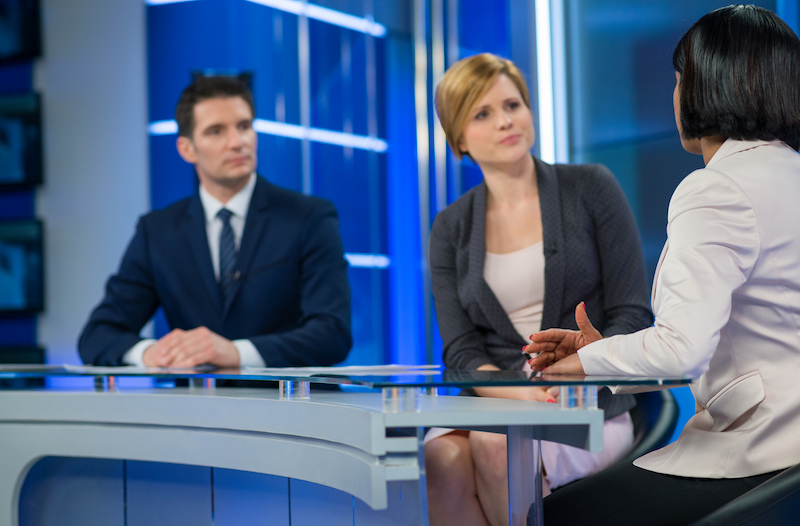Out of all the media interview tips I give to clients; number one is to always have a clear set of core messages.
Despite spending countless hours on zoom calls, when it comes to being recorded for a media interview, there’s always fear we’ll freeze-up, and fail to deliver the key messages we want to share with the world.
It’s frustrating, but it’s not surprising. Doing a media interview is a completely different form of communication than we’re used to. Which is why, in years past, CEOs and executives received media training. But now, we’re simply expected to sit in front of the camera and perform.
In this article, I want to share some of the basic media training tips I offer to my clients as I prepare them for interviews.
While some of these tips will be useful for podcast interviews, they’re definitely more focussed on how to manage interviews with the media and journalists.
With some simple presentation techniques you’ll maintain control of your message, to ensure the final edit contains the soundbites that you really care about, rather than sections that make you cringe.
Go beyond just answering questions; engage your audience, and be interesting in an interview!
Prepare (but not too much)

Media interview preparation is an important part of the process. But the common trap is to write out a script for your whole presentation.
Even if you tell yourself you won’t read it, you’ll become dependent on it.
You’ll end up trying to remember whole paragraphs of text, rather than clearly articulating your key message.
People want to hear from the real you, they don’t want to hear you read your notes.
I know how hard this can be. You’re an expert in your field, you spend all day digging into the details, and on some subjects, you actually do know it all. That comes in handy when you’re debating product strategy with your team, but when you’re in an interview, you need to use a different tone.
You want to avoid diving deep into the details, and instead, focus on delivering a succinct summary of the topic.
The hard part here is suppressing the inner urge to explain EVERY angle and nuance of the issue at hand. When you’ve only got 90 seconds, you need to get to the point, fast.
The best approach is to focus on 2 or 3 key messages that you want to articulate.
The Power of Perfecting Your Key Message

I get asked for media interview tips a lot, and my number one answer, is to always focus on your key message.
With a crisp set of key messages, you can walk into any interview feeling confident you’ll make your point.
While the interviewer has control of the questions, you’re in control of choosing what’s important.
We all may think we know the key points we want to discuss, but if it’s only in your head, you’ll find it hard to deliver them clearly under the glare of the interview lights.
This is the time when you should get some ideas down on paper, but you need to be specific and keep it high level.
Our modern world is saturated in media. Everyday we absorb thousands of messages from our phones, TV, computers, billboards and the people around us.
If you want your message to cut through the noise, you need to be engaging (free of jargon) and memorable (tell stories not lectures).
With that in mind, write down three key points (your key messages) that you want to get across to the audience.
Think of each message as sitting at the top of a pyramid, with layers of information below it. There’s countless ways you could expand on each topic. But, the point here is to capture it all in that one, simple, catchy statement.
If you’re consistent with how you articulate your messages, they’ll stick.
Having clarity on your core messages is a vital part of building an effective content strategy. It’s one more brick to put in place, as you build both your corporate and personal brand.
This process is hard, but the payoff is huge. Going through the exercise itself will force you to assess what’s really important. And as you trim both the buzzwords and the jargon, you’ll make connections between concepts that you may not have seen before.
And beyond the interview, you’ll have more confidence to share your ideas, and boost your influence.
This is a key challenge for investors focussed on ESG and impact, where education and clarity around complex new ideas is key.
Most Media Interview Tips Forget to talk about STYLE

Style is everything, and with a neat framework of key messages, you’ll approach the interview with confidence.
In the interview itself, you want to deliver your point of view clearly, and then back it up with some examples, and maybe a sprinkling of stories.
A simple formula is to state your position, clearly and with confidence. And then offer one or two points to back it up.
Then finish your point cleanly, no need to waffle.
This is one of those media interview tips you’ve probably heard before, but it really helps.
A good soundbite is a good trade.
Interviewers are always under a deadline, so they’ll be looking for a shortcut. If you can offer them a succinct soundbite, it’ll increase the likelihood the’ll will run with it, and you’ll retain control of the message.
Be brief, be succinct.
Imagine you’re explaining it to a fidgeting 15 year old. Get to the point! And don’t use jargon.
In a media interview you have one, maybe two, minutes to answer each question, max. For a podcast, it may be longer, but you still need to bring your key point up-front.
Don’t bury the lead.
The first words you say, your first sentence, should answer the question. A good discipline is to think; if I only had ten seconds to answer this question, what would I say?
Essentially you’re flipping the narrative, you’re bringing your conclusion to the front.
Once that’s done, you can relax and offer some more detailed supporting points in the form of background information, statistics and anecdotes.
This is a great media interview example from Amit Bouri, CEO of the Global Impact Investment Network (GIIN)
The process so far has focussed on you, and the challenge of extracting a succinct message from your wealth of knowledge. But your message isn’t just about you, it should also focus on your audience.
It may be just one sentence, but you need to ensure you capture both your position, as well as the needs and goals of your audience.
Just like the ying and the yang represents balance and harmony, so too must your message.
Empathy; How to Understand What Your Audience Wants
Everything you do, should be in service of your audience.
Those listening are offering something supremely valuable in our modern media-soaked world, they’re giving you their attention.
But, they can turn-off. They have a mountain of emails screaming for their attention a mere mouse click away, so you need to get to the point, and help them understand how you’re going to make their life easier.
Essentially, you need to understand their needs and desires. This is the core of effective communication, and it starts with empathy.
The more you can understand and sympathize with the obstacles, challenges and aspirations of your audience, the more chance you have of your message cutting through.
Avoid talking about the FEATURES of your business strategy, and instead, describe the BENEFITS for your potential customers, and how it solves a core problem for them.
Here’s an exercise to try:
- Draw three circles, each representing one of three groups: you, the audience, and the interviewer.
- For each group, write a few simple statements about what is most important to them, in terms of this interview.
- With empathy, transport yourself to take their perspective. And try to understand what they will get out of the interview.
- Now, try to bring these circles together into a venn diagram. Do they intersect? Is there a point where the interests of all three come together?
- If you can identify this meeting point, then you’ve found a powerful message that will resonate.
Anticipate questions
Now that you’ve flexed your empathy muscle, you can go a little deeper and think about what your interviewer is hoping to get out of this whole process? What’s their angle?
- Soundbites for their social media?
- Long-form exploration of a complicated topic?
- Or, are they a sensationalist journalist hoping to record a ‘gotcha’ quote?
Don’t be afraid to discuss this with the interviewer beforehand. Just ask!
Once you’re clear on what’s motivating the interviewer, you can start to jot down some potential questions they’re likely to ask.
Just remember, they’re not trying to reinvent the wheel. Your’s is just one of many interviews.
Understanding their angle will help you maintain a feeling of power and control during the process.
Rehearsing is better than writing.
An interview will involve you answering questions, not writing. So to prepare, you’re better off practicing the presentation of your messages, rather than writing it down.
Find a colleague, a friend, a partner; someone to help you workshop some potential questions, and then give it a test run.
This is a great way to shake off the nerves in a low-stakes environment.
Final Media Interview Tip… Practice in Private
We’ve all got a camera in our pocket. So take out your phone, set it on selfie mode, and have a go.
Take a deep breath, and present your core message to camera.
Watch it, critique it, then try again.
You’ll squirm and cringe, but the process is invaluable.
No more need for media interview tips, you’re ready.
Go on, what’ve you got to lose?




